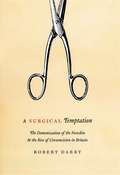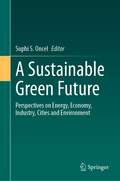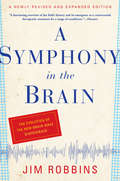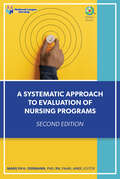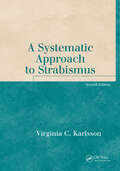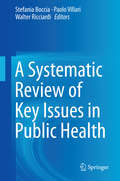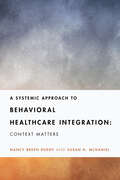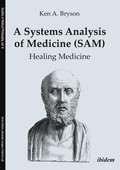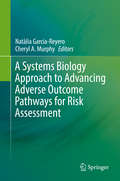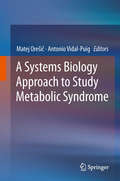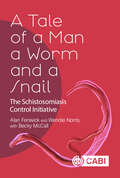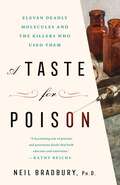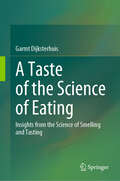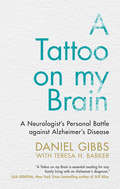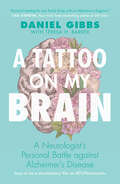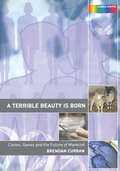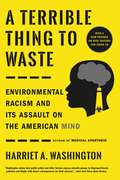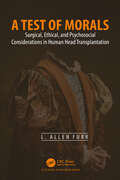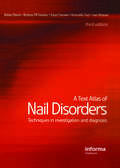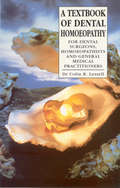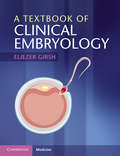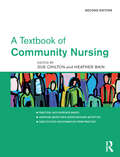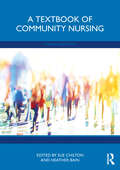- Table View
- List View
A Surgical Temptation: The Demonization of the Foreskin & the Rise of Circumcision in Britain
by Robert DarbyIn the eighteenth century, the Western world viewed circumcision as an embarrassing disfigurement peculiar to Jews. A century later, British doctors urged parents to circumcise their sons as a routine precaution against every imaginable sexual dysfunction, from syphilis and phimosis to masturbation and bed-wetting. Thirty years later the procedure again came under hostile scrutiny, culminating in its disappearance during the 1960s. Why Britain adopted a practice it had traditionally abhorred and then abandoned it after only two generations is the subject of A Surgical Temptation. Robert Darby reveals that circumcision has always been related to the question of how to control male sexuality. This study explores the process by which the male genitals, and the foreskin especially, were pathologized, while offering glimpses into the lives of such figures as James Boswell, John Maynard Keynes, and W. H. Auden. Examining the development of knowledge about genital anatomy, concepts of health, sexual morality, the rise of the medical profession, and the nature of disease, Darby shows how these factors transformed attitudes toward the male body and its management and played a vital role in the emergence of modern medicine.
A Surgical Temptation: The Demonization of the Foreskin and the Rise of Circumcision in Britain
by Robert DarbyIn the eighteenth century, the Western world viewed circumcision as an embarrassing disfigurement peculiar to Jews. A century later, British doctors urged parents to circumcise their sons as a routine precaution against every imaginable sexual dysfunction, from syphilis and phimosis to masturbation and bed-wetting. Thirty years later the procedure again came under hostile scrutiny, culminating in its disappearance during the 1960s. Why Britain adopted a practice it had traditionally abhorred and then abandoned it after only two generations is the subject of A Surgical Temptation. Robert Darby reveals that circumcision has always been related to the question of how to control male sexuality. This study explores the process by which the male genitals, and the foreskin especially, were pathologized, while offering glimpses into the lives of such figures as James Boswell, John Maynard Keynes, and W. H. Auden. Examining the development of knowledge about genital anatomy, concepts of health, sexual morality, the rise of the medical profession, and the nature of disease, Darby shows how these factors transformed attitudes toward the male body and its management and played a vital role in the emergence of modern medicine.
A Sustainable Green Future: Perspectives on Energy, Economy, Industry, Cities and Environment
by Suphi S. OncelThe aim of this book is to open a vision to sustainability and development through a holistic perspective comprising the critical blocks of energy, environment and economy. From renewable energy, urban infrastructure, societal health to industrial symbiosis, the book assesses critical issues to reach a green future with realistic solutions proposed by a diverse range of multidisciplinary experts. It is intended for a broad readership of academics, researchers and industry experts focusing on these fields, and with specializations in sustainability. The book is divided into different clusters starting with an introductory foreword to express the theme of the book and the route of the titles. The first cluster of the book highlights various multidisciplinary perspectives considering the interaction between different expertise. From engineering to economy supported with social pillars, this section gives the critical points of selected topics to focus on the future with a sustainability vision. The second cluster focuses on health issues, with discussion about the impacts of the COVID-19 pandemic and the way forward. Critical points like vaccines, health care and food security are highlighted. The third cluster is comprised of titles related to the urban environment and infrastructure. New solutions and discussions on biodesign, waste management and transportation are covered in this section. The last cluster covers energy, and highlights renewable energies such as bioethanol, biogas and wind.
A Symphony in the Brain: The Evolution of the New Brain Wave Biofeedback
by Jim RobbinsA Newly Revised and Expanded EditionIn the decade since Jim Robbins’s A Symphony in the Brain was first published, the control of our bodies, brains, and minds has taken remarkable leaps. From neurofeedback with functional magnetic resonance imaging equipment, to the use of radio waves, to biofeedback of the heart and breath, and coverage of biofeedback by health insurance plans, the numerous advances have driven the need for a revised edition to this groundbreaking book that traces the fascinating, untold story of the development of biofeedback.Discovered by a small corps of research scientists, this alternative treatment allows a patient to see real-time measurements of their bodily processes. Its advocates claim biofeedback can treat epilepsy, autism, attention deficit disorder, addictions, and depression with no drugs or side effects; bring patients out of vegetative states, even improve golf scores or an opera singer’s voice. But biofeedback has faced battles for acceptance in the conservative medical world despite positive signs that it could revolutionize the way an incredibly diverse range of medical and psychological problems are treated. Offering a wealth of powerful case studies, accessible scientific explanations, and dramatic personal accounts, Robbins remarkable history develops our understanding of this important field.
A Systematic Approach to Evaluation of Nursing Programs
by Marilyn OermannAs the need for high-quality nursing programs, new programs, and new delivery methods continues to grow, systematic and ongoing program evaluation is increasingly critical to the success of nursing schools at all levels of education. A Systematic Approach to Evaluation of Nursing Programs, Second Edition, equips nurse educators, administrators, and others involved in program evaluation with truly transformative strategies for conducting ongoing formative and summative evaluation of nursing programs. This approachable resource combines in one concise volume detailed coverage of the concepts nurse educators must understand to engage in program evaluation and accreditation as well as examples and practical strategies for successfully applying those concepts. Updated with the latest perspectives from respected authorities across the field of nursing education and new chapters, this second edition provides the current, comprehensive support needed to confidently engage in program evaluation and build stronger nursing education programs.
A Systematic Approach to Strabismus (The Basic Bookshelf for Eyecare Professionals)
by Virginia KarlssonWritten for the true beginner, the updated and revised second edition of A Systematic Approach to Strabismus examines the basic types of strabismus, ocular motility, ocular examination of pediatric patients, and extraocular muscle anatomy and functions.Unique features inside the Second Edition: Uses practical and easy-to-follow “how to” instructions to offer fundamental education on the four parts of an eye exam: history, vision, sensory testing, and motor testing Includes necessary information to successfully complete pediatric and strabismus eye exams Highlights the order of testing in an effort to gather the most important information prior to a pediatric meltdown and to avoid "exam pollution" Having worked in both private practice and university settings, Virginia Karlsson brings over 30 years of experience with pediatric ophthalmology and adult strabismus to the pages of A Systematic Approach to Strabismus, Second Edition. Ophthalmic technologists, technicians, assistants, residents, and students will welcome this unique book into their education and career.
A Systematic Review of Key Issues in Public Health
by Stefania Boccia Paolo Villari Walter RicciardiThis wide-ranging study reviews the state of public health worldwide and presents informed recommendations for real-world solutions. Identifying the most urgent challenges in the field, from better understanding the causes of acute diseases and chronic conditions to reducing health inequities, it reports on cost-effective, science-based, ethically sound interventions. Chapters demonstrate bedrock skills essential to developing best practices, including flexible thinking for entrenched problems, conducting health impact assessments, and working with decision-makers. From these current findings come long-term practice and policy goals for preventing disease, promoting health, and improving quality of life, both locally and globally. A sampling of the topics covered: · Health trends of communicable diseases. · Epidemiology of cancer and principles of prevention. · Respiratory diseases and health disorders related to indoor and outdoor air pollution. · Public health gerontology and active aging. · Migrant and ethnic minority health. · Public health genomics. A Systematic Review of Key Issues in Public Health offers graduate students in the discipline a firm grasp on the field as it presently stands, and a clear set of directions for its potential future.
A Systemic Approach to Behavioral Healthcare Integration: Context Matters (Fundamentals of Clinical Practice With Couples and Families Series)
by Dr. Nancy Breen Ruddy PhD Dr. Susan H. McDanielThis book provides clinicians, consultants, and healthcare administrators with a roadmap to establishing a systemic, patient-centered, family-oriented behavioral health service that is integrated into a healthcare setting. Healthcare that goes beyond biomedical issues to address our whole biopsychosocial selves, produces better outcomes for patients and families. Integrating behavioral health into medical settings requires an understanding of the interplay of multiple systemic layers in American healthcare. The existing literature on integration largely fails to address the "big picture" of integrated services and systems, including operations, clinical processes, and financial sustainability elements.A Systemic Approach to Behavioral Healthcare Integration summarizes the literature on the impact of integrating behavioral health care into medical settings, on the role of families in health maintenance and chronic disease management, and on team science and applying family systems theory/relational science to the teams that are now essential to healthcare.
A Systems Analysis of Medicine: Healing Medicine (Studies in Medical Philosophy #6)
by Ken A. BrysonThis book is a must read for anyone interested in transforming the impersonal character of the medical experience into a personalized, relational, spiritual, and holistic dialogue about human health. It promotes a holistic vision of the doctor-patient relationship, a medicine that ought to be based on the totality of the human experience rather than on the reductive view of the patient as a person with a certain disease. Ken A. Bryson describes the character of medicine as the gateway to holistic healing and argues that we need to secure the ethical foundation of universal medicine as not relative to a cultural setting, thus establishing the Oath of Hippocrates as the universal gateway to human dignity. This view emboldens us to raise medicine from the level of an impersonal technological encounter with disease to its rightful place as a sacred activity that includes all the levels of the human experience. The book offers practical suggestions on how to accomplish that objective.
A Systems Biology Approach to Advancing Adverse Outcome Pathways for Risk Assessment
by Natàlia Garcia-Reyero Cheryl A. MurphySocial pressure to minimize the use of animal testing, the ever-increasing concern on animal welfare, and the need for more human-relevant and more predictive toxicity tests are some of the drivers for new approaches to chemical screening. This book focuses on The Adverse Outcome Pathway, an analytical construct that describes a sequential chain of causally linked events at different levels of biological organization that lead to an adverse health or ecotoxicological effect. While past efforts have focused on toxicological pathway-based vision for human and ecological health assessment relying on in vitro systems and predictive models, The Adverse Outcome Pathway framework provides a simplified and structured way to organize toxicological information. Within the book, a systems biology approach supplies the tools to infer, link, and quantify the molecular initiating events and the key events and key event relationships leading to adverse outcomes. The advancement of these tools is crucial for the successful implementation of AOPs for regulatory purposes.
A Systems Biology Approach to Study Metabolic Syndrome
by Matej Orešič Antonio Vidal-PuigThe aim of this book is to provide the target audience, specifically students of Medicine, Biology, Systems Biology and Bioinformatics, as well as experienced researchers in research fields relevant to metabolic syndrome (MetS) with an overview of the challenges and opportunities in systems biology and how it can be used to tackle MetS. In particular, the aims are: (1) to provide an introduction to the key biological processes involved in the pathophysiology of MetS; (2) through the use of specific examples, provide an introduction to the latest technologies that use a systems biology approach to study MetS; and (3) to give an overview of the mathematical modeling approaches for studying MetS. The clearly written chapters by leading experts in the field provides detailed descriptions crucial for the unique position of this book and its focus on the application of systems biology to tackle specific pathophysiologically relevant aspects of MetS and provides a valuable practical guide to this research community.
A Tale of a Man, a Worm and a Snail: The Schistosomiasis Control Initiative
by Alan Fenwick Dr Wendie Norris Becky McCallSchistosomiasis is Africa's second most common parasitic disease. Less than 20 years ago, over 200 million were infected. In many high-risk areas the Schistosomiasis Control Initiative (SCI) has been helping to tackle the disease by offering treatments to millions of children. This book tells the story of a man, Alan Fenwick, who founded the SCI to control the worms and snails and so improve the lives of many burdened with the disease as well as reducing the numbers infected. Over this period SCI and the Ministries of Health and Education in 16 countries delivered over 220 million treatments. Treatment coverage of up to 75% has been achieved. Widely recognised as a cost-effective and successful intervention, SCI's knock-on effects include improving overall physical health, school attendance and future prospects for millions of people. The authors explore the work and experiences involved in forming, establishing and managing a health intervention system such as the SCI, while describing important lessons for anyone looking to replicate the success. This book covers: - Challenges faced and how the SCI overcame them to achieve its success; - Raising funds to deliver donated medicines; - Development of innovative partnerships; - Cultivation of working relationships and implementation across Africa; - A new model for other Neglected Tropical Disease programmes (NTDs); - Aspects of Alan's life in Africa told with memorable and often humorous anecdotes. A Tale of a Man, a Worm and a Snail is an essential resource for researchers, policymakers, health professionals and students of NTD control. The book is an enlightening, informative and enjoyable read for anyone interested in global health.
A Taste for Poison: Eleven Deadly Molecules and the Killers Who Used Them
by Neil Bradbury“A fascinating tale of poisons and poisonous deeds which both educates and entertains.” --Kathy ReichsA brilliant blend of science and crime, A TASTE FOR POISON reveals how eleven notorious poisons affect the body--through the murders in which they were used. As any reader of murder mysteries can tell you, poison is one of the most enduring—and popular—weapons of choice for a scheming murderer. It can be slipped into a drink, smeared onto the tip of an arrow or the handle of a door, even filtered through the air we breathe. But how exactly do these poisons work to break our bodies down, and what can we learn from the damage they inflict? In a fascinating blend of popular science, medical history, and true crime, Dr. Neil Bradbury explores this most morbidly captivating method of murder from a cellular level. Alongside real-life accounts of murderers and their crimes—some notorious, some forgotten, some still unsolved—are the equally compelling stories of the poisons involved: eleven molecules of death that work their way through the human body and, paradoxically, illuminate the way in which our bodies function. Drawn from historical records and current news headlines, A Taste for Poison weaves together the tales of spurned lovers, shady scientists, medical professionals and political assassins to show how the precise systems of the body can be impaired to lethal effect through the use of poison. From the deadly origins of the gin & tonic cocktail to the arsenic-laced wallpaper in Napoleon’s bedroom, A Taste for Poison leads readers on a riveting tour of the intricate, complex systems that keep us alive—or don’t.
A Taste of the Science of Eating: Insights from the Science of Smelling and Tasting
by Garmt DijksterhuisWhy do you taste what you taste, and what about smelling? Many books address good food, but few go deeper, explaining the processes behind smelling and tasting. The book addresses the senses of smell and taste and the many more senses and their interactions during eating. It also stresses the importance of psychology when you smell, taste and eat. Some of the other topics include flavour, the working of the nose and olfactory (cross-)adaptation, the use of odorants, the relation between emotion and eating, and many more. The book helps you understand why you like and eat food, and shows the intriguing complexity of the area.
A Tattoo on my Brain: A Neurologist's Personal Battle against Alzheimer's Disease
by Teresa H. Barker Daniel GibbsDr Daniel Gibbs is one of 50 million people worldwide with an Alzheimer's disease diagnosis. Unlike most patients with Alzheimer's, however, Dr Gibbs worked as a neurologist for twenty-five years, caring for patients with the very disease now affecting him. Also unusual is that Dr Gibbs had begun to suspect he had Alzheimer's several years before any official diagnosis could be made. Forewarned by genetic testing showing he carried alleles that increased the risk of developing the disease, he noticed symptoms of mild cognitive impairment long before any tests would have alerted him. In this highly personal account, Dr Gibbs documents the effect his diagnosis has had on his life and explains his advocacy for improving early recognition of Alzheimer's. Weaving clinical knowledge from decades caring for dementia patients with his personal experience of the disease, this is an optimistic tale of one man's journey with early-stage Alzheimer's disease.
A Tattoo on my Brain: A Neurologist's Personal Battle against Alzheimer's Disease
by Teresa H. Barker Daniel GibbsDr Daniel Gibbs is one of 50 million people worldwide with an Alzheimer's disease diagnosis. Unlike most patients with Alzheimer's, however, Dr Gibbs worked as a neurologist for twenty-five years, caring for patients with the very disease now affecting him. Also unusual is that Dr Gibbs had begun to suspect he had Alzheimer's several years before any official diagnosis could be made. Forewarned by genetic testing showing he carried alleles that increased the risk of developing the disease, he noticed symptoms of mild cognitive impairment long before any tests would have alerted him. In this highly personal account, Dr Gibbs documents the effect his diagnosis has had on his life and explains his advocacy for improving early recognition of Alzheimer's. Weaving clinical knowledge from decades caring for dementia patients with his personal experience of the disease, this is an optimistic tale of one man's journey with early-stage Alzheimer's disease. Soon to be a documentary film on MTV/Paramount +.
A Terrible Beauty is Born: Clones, Genes and the Future of Mankind (Science Spectra Ser.)
by Brendan CurranGenetics and its related technologies are revolutionizing the world. The media is regularly dominated by controversy over the latest genetically modified (GM) food, human gene therapy or cancer chip technology. Maverick scientists are in the process of cloning humans, and the human genome sequence is available on the Internet. Fifty years ago we di
A Terrible Thing to Waste: Environmental Racism and Its Assault on the American Mind
by Harriet Washington<P><P>Did you know...Middle-class African American households with incomes between $50,000 and $60,000 live in neighborhoods that are more polluted than those of very poor white households with incomes below $10,000. <P><P>When swallowed, a lead-paint chip no larger than a fingernail can send a toddler into a coma -- one-tenth of that amount will lower his IQ. <P><P>Nearly two of every five African American homes in Baltimore are plagued by lead-based paint. Almost all of the 37,500 Baltimore children who suffered lead poisoning between 2003 and 2015 were African American.From injuries caused by lead poisoning to the devastating effects of atmospheric pollution, infectious disease, and industrial waste, Americans of color are harmed by environmental hazards in staggeringly disproportionate numbers. <P><P>This systemic onslaught of toxic exposure and institutional negligence causes irreparable physical harm to millions of people across the country-cutting lives tragically short and needlessly burdening our health care system. But these deadly environments create another insidious and often overlooked consequence: robbing communities of color, and America as a whole, of intellectual power. <P><P>The 1994 publication of The Bell Curve and its controversial thesis catapulted the topic of genetic racial differences in IQ to the forefront of a renewed and heated debate. <P><P>Now, in A Terrible Thing to Waste, award-winning science writer Harriet A. Washington adds her incisive analysis to the fray, arguing that IQ is a biased and flawed metric, but that it is useful for tracking cognitive damage. <P><P>She takes apart the spurious notion of intelligence as an inherited trait, using copious data that instead point to a different cause of the reported African American-white IQ gap: environmental racism - a confluence of racism and other institutional factors that relegate marginalized communities to living and working near sites of toxic waste, pollution, and insufficient sanitation services. <P><P>She investigates heavy metals, neurotoxins, deficient prenatal care, bad nutrition, and even pathogens as chief agents influencing intelligence to explain why communities of color are disproportionately affected -- and what can be done to remedy this devastating problem. Featuring extensive scientific research and Washington's sharp, lively reporting, A Terrible Thing to Waste is sure to outrage, transform the conversation, and inspire debate.
A Test of Morals: Surgical, Ethical, and Psychosocial Considerations in Human Head Transplantation
by L. Allen FurrWhile transplanting human heads is not a new concept, the idea has largely been relegated to religious lore or as a plot device in science fiction. But now, a surgical plan to perform the complex procedure exists, and though most physicians question head transplantation’s medical veracity, bioethicists have challenged the surgery on moral grounds. A Test of Morals compiles and examines the ethical questions that dog those who advocate for conducting this most radical of medical proposals in order to determine if society should move forward and allow head transplantation to occur. Current bioethical principles stand in opposition to head transplantation, causing a conflict of values rarely seen in medicine.
A Text Atlas of Nail Disorders: Techniques in Investigation and Diagnosis
by Antonella Tosti Robert Baran Eckart Haneke Ivan Bristow Rodney Pr DawberLike its predecessors, Text Atlas of Nail Disorders, third edition is destined to become an invaluable diagnostic tool. The authors comprehensively cover pathologies affecting the toe and finger nails. They profile each pathology, from common to rare disorders, and support them with extensive color photographs. This latest edition contains new mate
A Textbook Of Dental Homoeopathy: For Dental Surgeons, Homoeopathists and General Medical Practitioners
by Dr Colin B. LessellThis book has long been awaited by professionals - a complete, modern, practical and usable book on the application of homoeopathy to oral medicine, general dentistry and oral surgery.It will not be out of place on the bookshelf or in the office of any dental surgeon, committed homoeopathist or medical doctor.The first and lesser part of the book is a basic introduction to the principles of homoeopathy. The second and greater part is in encyclopaedic form, being a combined therapeutic index of orofacial disease and materia medica of virtually all the therapeutic substances mentioned in the text. It also constitutes a self-tuition course in dental homoeopathy. Appendix One suggests the structure for an initial dental pharmacy in clinical practice, and Appendix Two contains a modern view of the important matter of mercury toxicity.
A Textbook of Clinical Embryology
by Eliezer GirshPersonnel working in assisted reproductive technology often lack the opportunities for dedicated training in the specialized techniques and technologies required for the procedures. As such, success in the form of live birth rates can range from over 50% to less than 10% per treatment cycle. This comprehensive introductory textbook is an essential resource for trainee embryologists, medical students and nurses. The recent revolutions in biotechnology and molecular biology involved in delivering assisted reproductive services are thoroughly discussed. Basic knowledge such as the development and physiology of both male and female reproductive systems is covered, with practical aspects of IVF including gamete and embryo manipulation, cryopreservation and genetic testing explained in detail. A full description of the optimal structure and management of the IVF laboratory is given, helping ensure procedures are safe and effective. Extensive and highly detailed colour illustrations bring the content to life and aids readers in their understanding.
A Textbook of Clinical Pharmacology and Therapeutics, 5Ed
by Albert Ferro James Ritter Timothy Mant Lionel LewisIf you understand how drugs work (pharmacodynamics), how they are handled by the body (pharmacokinetics), how they interact with each other, and how drug treatments are assessed, then you will become a better prescriber. A Textbook of Clinical Pharmacology and Therapeutics gives you that understanding.Fully revised throughout and extensively illust
A Textbook of Community Nursing
by Sue Chilton Heather Bain<p>A Textbook of Community Nursing is a comprehensive and evidence-based introduction covering the full range of professional topics, including professional approaches to care, public health, eHealth, therapeutic relationships and the role of community nursing in mental health. The new edition has been updated throughout, including new guidelines and policies. It also provides a stronger focus on evidence-based practice. <p>This user-friendly and accessible textbook includes: <p> <li>Current theory, policy, and guidelines for practice. All chapters are underpinned by a strong evidence base; <li>Learning objectives for each chapter, plus exercises and activities to test current understanding, promote reflective practice, and encourage further reading; <li>Case studies and examples from practice which draw on all branches of community nursing to illustrate practical application of theory.</li> <p> <p>This is an essential text for all pre-registration nursing students, students on specialist community nursing courses, and qualified nurses entering community practice for the first time.</p>
A Textbook of Community Nursing
by Sue Chilton Heather BainThis third edition is a comprehensive and evidence-based introduction to this essential area of practice. Fully updated to take into account the wide range of nursing roles in the community, it provides an integrated approach to care, with a focus on physical and mental wellbeing.It covers a wide range of topics, including research and community nursing, public health, professional approaches to care, risk management, safeguarding, therapeutic relationships, care across the lifespan, community nursing assessment, mental health, carers and families, spirituality, leading person-centred care, and digital healthcare.Incorporating current theory, policy and guidelines for practice, and underpinned by a strong evidence base, each chapter features learning objectives and activities. Case studies and examples from practice serve to illustrate the practical application of theory throughout.This is an essential text for all pre-registration nursing students, students on post-registration specialist community nursing courses and qualified nurses entering community practice for the first time.
